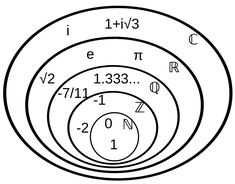
Some "Eurekas" of Mathematics - Part Three
First published: Tuesday May 11th, 2021
Report this blog
Our Number System
The Arabic numeral system is the one that you are all probably most familiar with. It is the most widespread and virtually used everywhere. It consists of 10 symbols (0,1,2,...) which are used to represent any number imaginable. Well, almost any number imaginable. This positional decimal system has its strengths, but it also has its weaknesses. Today we're going to focus in on one weakness which I find particularly interesting.
Repeating Decimals
I'm sure you're all familiar with the concept of a repeating decimal. In our numerical system, some numbers cannot be represented using a finite number of symbols. For example, if you take the number 1 and divide it into three equal parts, you end up with the number 1/3. But this representation is not in decimal notation. To write it using a decimal point and the 10 symbols mentioned above, you end up with
0.3333333....
repeating infinitely. This alone makes our Arabic numeral system somewhat tedious.
Uniqueness of Numbers
(Just a warning, this next part can be a little bit confusing, but I'll include a very crude description so that you get the basic idea of what's going on.)
Now, let's say you wanted to write out every possible (real) number that exists. So you start by writing 0.00000..., then 1.00000..., then 1.10000..., 1.11000... Then you do the same but with 2, then 3, then 4, etc. It's important to note that, in order to finish, you would need an infinite amount of time. Then you start combining symbols. 1.12000..., 1.13000..., 1.14000, etc. It would be extremely time-consuming to do this, but if you gave a computer an infinite amount of time, theoretically it would come up with each and every number that exists exactly once, right? Not exactly.
In fact, some numbers would reappear more than once. How on earth could this be if we made sure that each decimal representation was unique?! In the next part, we will look at one such example of a number which has two unique decimal representations.
The Number 0.999999...
Okay, if you got bored and started skimming, this is where the interesting part kicks in. So start paying attention now!
What exactly is the number 0.9999...? Is it just barely less than the number 1? Looking at its decimal representation, this seems to be the most probable guess, but it would be wrong. In fact,0.99999... = 1.0 !
That is, they are the same number. In order to convince you of this, we can just look above to the first number with a repeating decimal that we looked at: 0.33333... This number is a third of the number 1, right? So if we multiply this number by 3, then we should get back to 1. Notice that multiplying 0.33333... by 3 results in 0.99999... So this should give us some intuition as to why these two decimal representations are equivalent.A Fun Proof

Conclusion
Hopefully now you're convinced that the two decimal representations 0.99999... and 1.0 both actually represent the same number. So there are some issues with the decimal number system that so many of us call our own. But at this point, there isn't any turning back from our numerical system. In fact, I'm personally quite fond of it despite its inconsistencies.

The thing with this number is that it stops, it has a finite number of nines, whereas if it had an infinite number of nines after the decimal place, it would in fact be equal to 100.